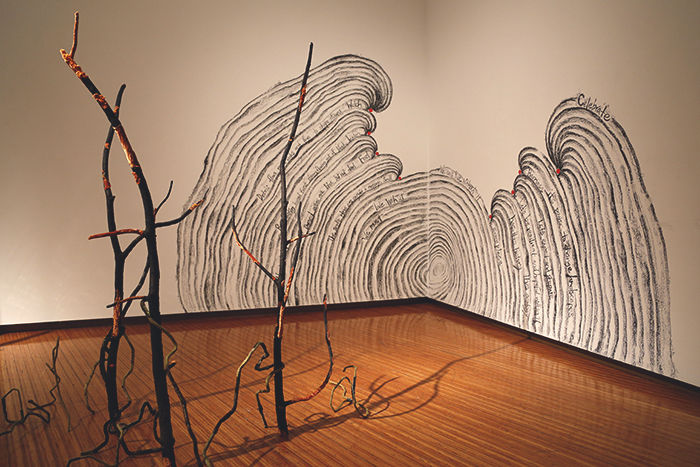Artwork inspired by science
A mixed medium piece of artwork, above, displayed at the Prichard Art Gallery for the “Visualizing Science” art exhibit. The exhibit features work created through the collaboration of local artists and scientists.
March 24, 2017
{{tncms-asset app=”editorial” id=”148586f0-104b-11e7-b735-7f4f8c79d889″}}
Combining the fields of art and science, an exhibit at Prichard Art Gallery aims to showcase current research to the public.
The Prichard Art Gallery opened the exhibit, “Visualizing Science,” on Feb. 10, featuring the work of University of Idaho faculty. The University of Idaho (UI) began the Vandal Ideas Project (VIP) last year to fund teams for increased collaboration and interdisciplinary approaches to issues and research.
Prichard Art Gallery Director Roger Rowley teamed up with UI Art and Design Chair Sally Machlis and put together a proposal for the project, he said. With improved funding, art faculty and the gallery could make themselves well known on campus.
A lot of the focus for the exhibit came from moving past STEM, which stands for science, technology, engineering and math, toward STEAM, which includes the arts, Rowley said.
From the proposal, they contacted interested art and science faculty to work on the project. Rowley and Machlis started with scientists they knew already had interest, and as part of the VIP program, they hosted a mixer to find more people for the project.
In the VIP mixer, science faculty gave five-minute presentations about their work and then approached Rowley to get involved. Rowley and Machlis then held a mini-version of the mixer, where science faculty gave short presentations about their research.
Each artists made a list of the top three researchers they wished to work with, but teams were already clear by the end of the mixer process, as immediate connections were made during presentations, Rowley said.
Rowley and Machlis set the framework while the teams had freedom to create their vision, he said. Each team had a unique process for their collaboration.
When working with an artist, Rowley said he generally looks for something that will develop in relation to the gallery. This collaboration normally happens over the course of two years, he said. With the VIP project, the process had to happen within a year, a tight timeframe for the art teams. This was the biggest challenge, but the teams accomplished their goals incredibly well, Rowley said.
Presenting the research in an accessible way also posed a challenge, Rowley said. The voice of the scientist had to come through the artwork, and their research, the main inspiration for each piece, had to stand out as well.
In the end, each team conducted interviews that were posted online and in the gallery for the public to view with the art. The gallery also included quotes from the scientists, Rowley said.
Rowley said he enjoys the process of creating these exhibitions because he finds it engaging.
“An exhibition is essentially a set of building blocks,” Rowley said. “It’s juggling those blocks until they fall into place.”
Approximately 450 people attended the opening reception of “Visualizing Science” on Feb. 10, compared to the 150 to 200 people that generally come to other exhibit openings, Rowley said.








